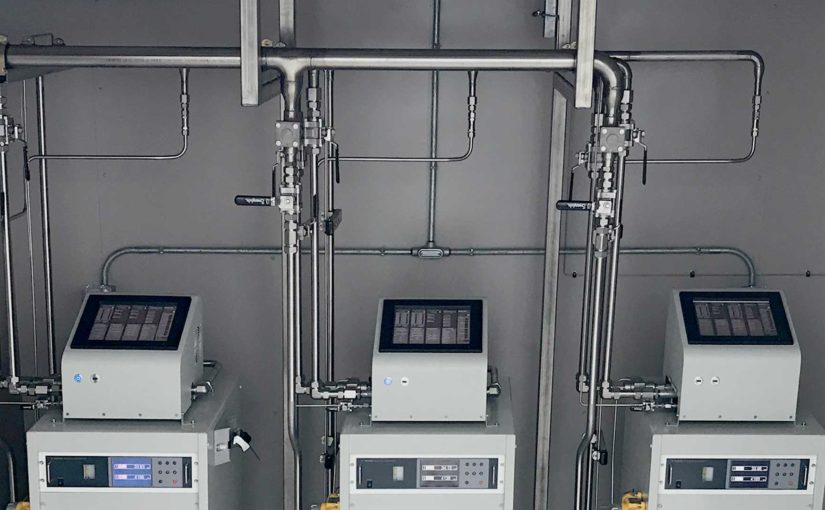Over the past few decades, Modified Atmosphere Packaging (MAP) has become a common solution for food manufacturers looking to extend the shelf life and reduce spoilage of packaged foods by adding gases during food packaging. Today, consumers and supermarkets continue to demand freshness as large food manufacturers are expanding their distribution footprint. Gas providers support manufacturers using Modified Atmosphere Packaging (MAP) by providing pure gases and expertly-mixed gas blends that achieve manufacturers’ goals for food freshness, appearance and flavor. As important as it is to select the right gases for your modified atmosphere packaging (MAP) application, it’s also important to ensure that the mixing technology you’re using is producing an accurate gas mix that achieves the desired result and complies with Food and Drug Administration (FDA) regulations.
Gas mixing technology plays an important role in the successful use of Modified Atmosphere Packaging (MAP) mixtures to extend the freshness of a product (which also allows food to be shipped farther). Innovative mixer features like flow matching, Calculated Theoretical Percentage (CTP) and concentration trim help ensure an accurate and reliable supply of expertly mixed gas to your process. Further, adding a gas analyzer to your process can help ensure compliance with FDA regulations, reducing the likelihood of wasted or recalled products.
Key #1: Maintain constant pressure with flow-matching gas mixers
Much like an air compressor used to fill your tires, some gas mixers tend to turn on and off throughout the day depending on demand. This downtime can cause mix imprecision since a gas mixer is less accurate when it initially turned on.
“The flow-matching function monitors the output pressure and adjusts the flow rate accordingly in order to feed a constant supply to the customer’s process and avoid continual stopping and starting, which can lead to an inaccurate gas mixture,” said Mark Doore, Director of Specialty and Process Equipment at Airgas, an Air Liquide company.
Key #2: Stick by your mixing standards with Calculated Theoretical Percentage
Although gas mixers used for Modified Atmosphere Packaging (MAP) are set to deliver a precise mix of gases to the process, there are potential inaccuracies. One example of this being when the mixer’s actual output differs significantly from the given command.
This raises an important question: Why is the mixer’s actual output different from the given command, anyway? According to Doore, “Cruise control is a helpful analogy that explains why there might be a difference between the command and actual output. If you set your cruise control for 65 mph, there may be times when your speedometer shows that your actual speed is 66 mph based on external factors, like a hill. Mixers may experience similar fluctuations in output.”
Calculated Theoretical Percentage (CTP) is the average of the mixer’s actual output of component gases delivered to a process over time. Comparing that CTP to the requested gas mixture would give you an idea of how accurately the gas mixer was performing. Knowing how a mixer is performing is essential to maintaining accurate specifications and avoiding costly mistakes.
A gas analyzer gives an independent measurement of the output mixture concentration, compared to a known gas calibration standard. In some cases, if there is no analyzer or if you can’t analyze the process gases using usual methods, CTP works in its place to check the performance of the mixer. Essentially, CTP achieves the same results as a gas analyzer, in that it allows you to track the gas mixer’s performance.
“While we don’t recommend CTP in place of an analyzer, it certainly gives us an indication of how the system is running and can trigger an alarm if the mixer is operating outside of normal ranges,” said Doore.
Key #3: Take control of consistency with Trim command
Consistency on the mixer’s front screen minimizes confusion when a new operator is at the helm of a mixer. The trim command helps maintain consistent settings on the front screen for operators while allowing for fine adjustments behind the scenes.
“Imagine that an operator at a plant walks up to a mixer knowing that the goal is a mix that’s 80 percent oxygen and 20 percent carbon dioxide, but an analyzer downstream shows that the mixer isn’t hitting its goal precisely. The trim command allows the operator to achieve a more accurate output by making small adjustments to the command behind the scenes while maintaining the coarse command on the mixer’s front screen,” said Doore. The trim command supports repeatability of a process and improves ease of use for operators.
One more key: Ensure compliance with gas analysis
To ensure that a mixer’s output complies with FDA regulations, a mixer should include an analyzer, which should be calibrated to a known standard. Airgas recommends using a calibration standard that is traceable to the National Institute of Standards and Technology (NIST)
Accurate MAP gas analysis helps reduce the likelihood of a recall caused by non-compliant gas mixtures and is essential to the safety of both the employees packaging food and the consumers purchasing the end product.
Reap the benefits of MAP with mixing technology
Effective tools that solve common issues throughout the MAP process help food processors reap all of the benefits of MAP and meet the quality demands of retailers and consumers. By expanding the distribution of a packaged good, food processors increase their potential sales and achieve the cost savings associated with minimizing waste and spoilage. Having the right mixer for a given application also supports ease of operability and compliance with FDA regulations, ensuring a safe, straightforward and cost-effective process.
Need help with your Modified Atmosphere Packaging (MAP) process? Connect with us >
